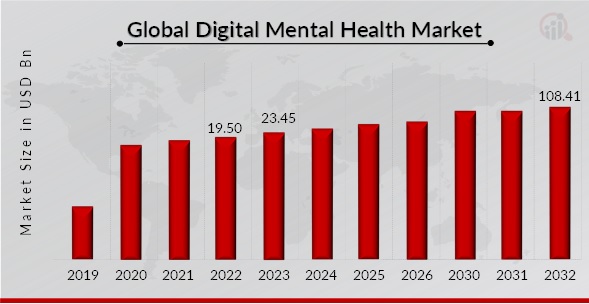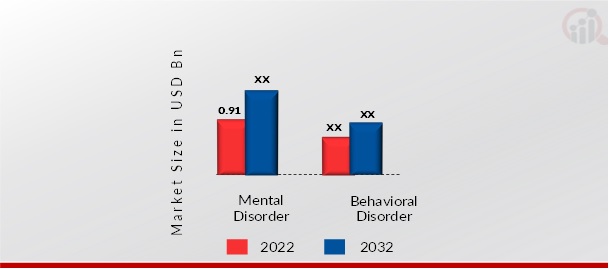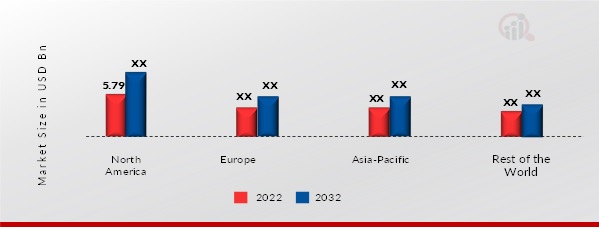Global Digital Mental Health Market Overview
Digital Mental Health Market size was valued at USD 19.50 billion in 2022. The Digital Mental Health Market industry is projected to grow from USD 23.45 billion in 2023 to USD 108.41 billion by 2032, exhibiting a compound annual growth rate (CAGR) of 18.54% during the forecast period (2023 - 2032).
The global market growth is propelled by several key factors, notably the rising prevalence of mental disorders and continual advancements in software technology.

Source: Secondary Research, Primary Research, MRFR Database and Analyst Review
Digital Mental Health Market Trends
- Increasing prevalence of mental disorders
The surge in mental health conditions globally has cast a shadow on the well-being of individuals worldwide, impacting not only their personal lives but also placing a strain on families and communities. According to the World Health Organization, approximately one in four people globally is expected to experience a mental health condition at some point in their lives, leading to nearly a billion individuals grappling with disorders like depression, anxiety, schizophrenia, and bipolar disorder. This concerning trend is not limited to specific regions, as evidenced by a notable increase in the prevalence of mental health conditions in the top 20 economies from 2019 to 2023.
In response to this growing crisis, the digital mental health market has emerged as a pivotal player, offering innovative solutions to address the complex challenges associated with mental health disorders. The rise of accessible digital platforms, including apps, online therapy services, and AI-powered tools, signifies a transformative shift in how individuals seek and receive mental health support. These solutions, characterized by their accessibility, convenience, anonymity, and personalized care capabilities, have become a beacon of hope for individuals navigating the complexities of mental health.
Additionally, the growth of the digital mental health market is significantly propelled by remarkable technological advancements that have transformed the landscape of mental health care. Artificial intelligence (AI) plays a pivotal role, contributing to the development of chatbots and virtual assistants capable of providing therapy and support to individuals dealing with mental health conditions. Moreover, AI-powered tools analyze data from wearables and other devices, enabling the tracking of an individual's mental health status and the prediction of potential problems, thereby offering proactive interventions. Virtual reality (VR) introduces immersive experiences designed to assist individuals with anxiety, phobias, and various mental health conditions. For instance, VR exposure therapy provides a safe and controlled environment for individuals to confront and gradually overcome their fears, especially relevant for those dealing with phobias like heights. Augmented reality (AR) is harnessed to develop applications and games that facilitate learning coping skills and symptom management for individuals with mental health conditions. AR apps, for instance, may guide individuals with anxiety through relaxation techniques, offering practical and interactive support.
Therefore, the rising incidences of mental disorders across the globe and rising awareness about the benefits of software-associated services and technological advancements are fostering market growth.
Digital Mental Health Market Segment Insights
Digital Mental Health Market Component Insights
Based on component, the Digital Mental Health Market is segmented into software and services. The software segment is segmented into cloud-based and web-based, and services segment is segregated into cognitive behavioral therapy, acceptance and commitment therapy (ACT), and other services. Software held the largest market share in 2022 and is anticipated to register the highest CAGR from 2022 to 2032. This growth is driven by technological advancements, increased awareness, and the recognition of the efficacy of digital tools in mental health treatment and support. In the realm of digital mental health, the distinction between web-based and cloud-based software plays a pivotal role, each with its unique characteristics. Web-based software operates locally on devices through web browsers, necessitating installation and storing data locally. This approach offers offline accessibility and heightened control over data security but may encounter performance limitations tied to device hardware. Manual updates characterize web-based software. On the other hand, cloud-based software operates on remote servers accessible through web browsers, eliminating the need for local installation. All data is processed and stored in the cloud, allowing unparalleled accessibility across devices. Automatic updates, scalability, and potential security concerns tied to the provider's infrastructure are hallmarks of cloud-based solutions.
Digital Mental Health Market Disorder Type Insights
Based on disorder type, the Digital Mental Health Market has been segmented into mental disorder and behavioral disorder. Mental disorder is divided into anxiety disorder, post-traumatic stress disorder, substance abuse disorder, schizophrenia, and other mental disorders, and behavioral disorders such as attention deficit hyperactivity disorder (ADHD), emotional behavioral disorder, oppositional defiant disorder, obsessive compulsive disorder (OCD), and other behavioral disorder. Mental disorder held the largest market share in 2022 and behavioral disorder is anticipated to register the highest CAGR from 2022 to 2032. This growth reflects the increasing acceptance and integration of digital interventions across a broad spectrum of mental health conditions. One of the major mental health disorder is anxiety disorders which manifests as conditions characterized by the overwhelming presence of intense and disproportionate worry and fear, significantly impacting daily life. Common types encompass generalized anxiety disorder, panic disorder, social anxiety disorder, and various phobias. Individuals grappling with anxiety disorders may experience symptoms such as racing thoughts, concentration difficulties, muscle tension, fatigue, and engagement in avoidance behaviors, all of which contribute to the disruption of their normal routines.
FIGURE 2: DIGITAL MENTAL HEALTH MARKET, BY DISORDER TYPE, 2022 & 2032 (USD BILLION)

Source: Secondary Research, Primary Research, MRFR Database and Analyst Review
Digital Mental Health Market Age Group Insights
Based on age group, the Digital Mental Health Market has been segmented into children & adolescents (10 to 19), adults (20 to 65), and geriatric (above 65). Adult (20 to 65) held the largest market share in 2022 and geriatric (above 65) is anticipated to register the highest CAGR from 2022 to 2032. This growth emphasizes the importance of digital mental health tools in addressing the unique mental health challenges faced by the elderly. Analyzing the growth trends of adults aged 20-65 across major economies from 2019 to 2023 reveals intriguing patterns both in percentage terms and as a share of the total population. Notably, emerging economies such as India, the Philippines, and Indonesia exhibit the fastest growth rates at 5.6%, 3.4%, and 3.1%, respectively. Moreover, factors such as increasing recognition of digital mental health interventions as effective tools for supporting the mental well-being of younger age groups is boosting the age group segment growth.
Digital Mental Health Market End User Insights
Based on end user, the Digital Mental Health Market is segmented into patients, payers, and providers. Providers held the largest market share in 2022 and patients’ segment is anticipated to register the highest CAGR during the forecast period. Several countries, including the United States, China, and India, grapple with a significant prevalence of mental health conditions. In the United States, approximately one in five adults’ experiences mental illness each year, underscoring the pervasive nature of the issue. China faces an estimated 17% of the population dealing with a mental disorder, while in India, mental health issues affect about 10% of the population. Moreover, various European countries, including France, Germany, and the UK, report high rates of anxiety and depression, contributing to the global mental health burden. Hence, the increasing mental health burden across the globe is fostering the growth of the digital mental health market.
Digital Mental Health Market Regional Insights
By region, the study segments the market into North America, Europe, Asia-Pacific, and the Rest of the World. North America accounted for the largest market share of over 29.72% in 2022 due to increasing awareness of mental health needs, and a technologically advanced population, region provides fertile ground for the development and adoption of digital solutions. The region's robust telecommunication infrastructure and strong investment environment further enhance its technological leadership, fostering innovation in digital mental health solutions. Moreover, the presence of established healthcare systems and diverse providers contributes to the integration of these solutions into mainstream care.
Further, the major countries studied are: The US, Canada, Brazil, Germany, France, the UK, Italy, Spain, China, India, Japan, South Korea, and Australia.
FIGURE 3: DIGITAL MENTAL HEALTH MARKET, BY REGION, 2022 & 2032 (USD BILLION)

Source: Secondary Research, Primary Research, MRFR Database and Analyst Review
Europe's digital mental health landscape is marked by significant strengths and opportunities, as well as notable weaknesses and threats. The region benefits from a growing awareness of mental health, fostering greater acceptance and openness to seeking help. Technological advancements, including AI-powered therapy tools and virtual reality exposure therapy, contribute to accessible and innovative solutions. The support from European Union initiatives, such as the Mental Health in All Policies framework and funding programs, further promotes the development and adoption of digital mental health solutions. The multilingual accessibility of digital platforms enhances inclusivity, catering to diverse European languages. Furthermore, the Germany digital mental health market held the largest market share in 2022 and UK digital mental health market is the fastest growing market in the Europe region.
The Asia-Pacific region is witnessing a surge in the adoption of digital mental health solutions, fueled by several key strengths. Over 60% of the population owns a smartphone, opening doors to a plethora of mental health apps and platforms. Stigma surrounding mental health is gradually fading, creating a more receptive environment for individuals to seek help through digital channels. Developers are increasingly catering to the diverse needs of the region by creating multilingual and culturally sensitive solutions. Moreover, governments are also playing a proactive role by promoting and funding promising initiatives. Moreover, China digital mental health market held the largest market share in 2022 and India digital mental health market is the fastest growing market in the Asia-Pacific region.
Digital Mental Health Market Key Market Players & Competitive Insights
The Digital Mental Health Market is characterized by the presence of many global, regional, and local players and factors such as improving infrastructure and increasing adoption of mental health software driving the growth of the Digital Mental Health Market. To expand their reach and optimize their operational costs, the major players focus on forming strategic and in order to gain a substantial market share.
Woebot Health (US), founded in 2017 and headquartered in San Francisco, is a private limited company offering AI-powered mental health support. Their main product, Woebot, acts as a confidential 24/7 chatbot therapist, utilizing techniques like CBT and ACT to guide users through their struggles. Woebot Health goes beyond individual support, too, offering integrations for healthcare providers and even developing custom AI tools for specific mental health needs. Furthermore, in March 2022, the company announced that Leaps by Bayer, the impact investment arm of Bayer AG, had made a $9.5 million strategic investment in the company to help accelerate further development of its AI-powered behavioral health platform and products. The stake in Woebot Health marks Leaps by Bayer's first investment in mental health, broadening a portfolio defined by a commitment to address the global need for pioneering solutions that deliver engaging and continuous care. The announcement followed Woebot Health’s $90 million Series B round in 2021 and brings total investment in the company to date to $123.5 million.
Key Companies in the Digital Mental Health Market includes
- Woebot Health (US)
- CareTech Holdings PLC (UK)
- Talkspace (US)
- Sonde Health, Inc. (US)
- Kintsugi Mindful Wellness,Inc. (US)
- BetterHelp (US)
- Ieso Digital Health (US)
Digital Mental Health Market Industry Developments
December 2023: Evernow (US), the foremost digital care platform catering to women in perimenopause, menopause, and beyond, has joined forces with Talkspace (US), a prominent online behavioral health company. This strategic partnership, announced today, marks a collaborative effort to provide enhanced mental health services and resources to their expanding member base, particularly focusing on women aged 40 and above who are navigating through this pivotal life stage. By combining their strengths, Evernow and Talkspace aim to enrich the toolkit available to their respective members, offering improved access, convenience, and personalized care for individuals addressing mental health issues during the menopause journey.
December 2023: Baltimore County Public Schools (US) announced a new partnership with Talkspace (US) a leading online behavioral health care company, to provide free, unlimited telehealth therapy for all BCPS high school students ages 13 and above. Beginning December 2023, more than 32,000 students have had access to high-quality messaging therapy and evidenced-based mental health resources.
November 2021: Smartbox Holdings (UK) a subsidiary of Caretech (UK) acquired REHAVISTA and LogBUK for €10mn.
Digital Mental Health Market Segmentation
Digital Mental Health Market Component Outlook
- Software
- Services
- Cognitive Behavioral Therapy
- Acceptance and Commitment Therapy (ACT)
- Other Services
Digital Mental Health Market Disorder Type Outlook
- Mental Disorder
- Anxiety Disorder
- Post-Traumatic Stress
- Substance Abuse Disorder
- Schizophrenia
- Other Mental Disorder
- Behavioral Disorder
- Attention Deficit Hyperactivity Disorder (ADHD)
- Emotional Behavioral Disorder
- Oppositional Defiant Disorder
- Obsessive Compulsive Disorder (OCD)
- Other Behavioral Disorder
Digital Mental Health Market Age Group Outlook
- Children & Adolescents (10 to 19)
- Adult (20 to 65)
- Geriatric (Above 65)
Digital Mental Health Market End User Outlook
- Patients
- Payers
- Providers
Digital Mental Health Market Regional Outlook
- North America
- Europe
- Germany
- France
- UK
- Italy
- Spain
- Rest of Europe
- Asia-Pacific
- China
- India
- Japan
- South Korea
- Australia
- Rest of Asia-Pacific
- Rest of the World
- Middle East and Africa
- Africa
|
Report Attribute/Metric
|
Details
|
|
Market Size 2022
|
USD 19.50 billion
|
|
Market Size 2023
|
USD 23.45 billion
|
|
Market Size 2032
|
USD 108.41 billion
|
|
Compound Annual Growth Rate (CAGR)
|
18.54% (2023-2032)
|
|
Base Year
|
2022
|
|
Forecast Period
|
2023-2032
|
|
Historical Data
|
2019 to 2021
|
|
Forecast Units
|
Value (USD Billion)
|
|
Report Coverage
|
Revenue Forecast, Competitive Landscape, Growth Factors, and Trends
|
|
Segments Covered
|
Component, Disorder Type, Age Group, End User, and Region
|
|
Geographies Covered
|
North America, Europe, Asia Pacific, and Rest of the World
|
|
Countries Covered
|
The US, Canada, Brazil, Germany, France, the UK, Italy, Spain, China, India, Japan, South Korea, Australia.
|
|
Key Companies Profiled
|
Woebot Health (US), CareTech Holdings PLC (UK), Talkspace (US), Sonde Health, Inc. (US), Kintsugi Mindful Wellness,Inc. (US), BetterHelp (US), and Ieso Digital Health (US)
|
|
Key Market Opportunities
|
· Government long term health plans
|
|
Key Market Drivers
|
· Increasing prevalence of mental disorders
· Technological advancements in digital mental health software
|
Frequently Asked Questions (FAQ) :
The Digital Mental Health Market is anticipated to reach 108.41 billion by 2032 at a CAGR of 18.54% during the forecast period of 2023-2032.
The US held 83.87% share of the North America for digital mental health market in 2022.
The Digital Mental Health Market is expected to grow at a 18.54% CAGR during the forecast period from 2023 to 2032.
The North America region market held the largest market share in Digital Mental Health Market.
The key players include Woebot Health (US), CareTech Holdings PLC (UK), Talkspace (US), Sonde Health, Inc. (US), Kintsugi Mindful Wellness, Inc. (US), BetterHelp (US), and Ieso Digital Health (US).
The software of component segment led the Digital Mental Health Market in 2022.
Mental disorder segment had the largest market in 2022 with a market share around 61.43%.





























